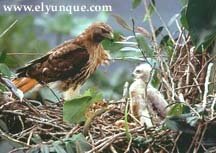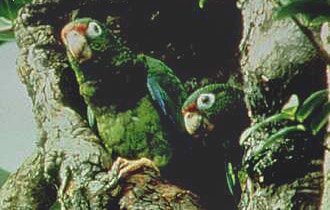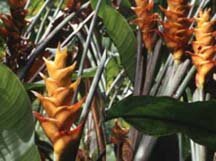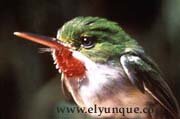Above: photo of Bromiliads and Sierra Palms on the path up to the peaks, by Professor John Niss.
|
Bromeliads are members of a plant family known as Bromeliaceae . The family contains over 3000 described species in approximately 56 genera. The most well known bromeliad is the pineapple. The family contains a wide range of plants including some very un-pineapple like member What is a rain forest? In the case of El Yunque in Puerto Rico it is all about being the first mountain to face the wind and catch all the rain.
The El Yunque Rain Forest is a cool, mountainous, sub tropical rainforest.
The Eastern side of the Luquillo Mountains, which has the El Yunque rainforest at the top elevations, gets most of the rain.
. . "The true sub tropical 'Rain forest' occupies very little area in Puerto Rico, only a single, crescent shaped, band on the windward side of the El Yunque mountains. It lies wholly within the El Yunque National Forest Reserve. This life zone is characterized by an annual total of 3,400 mm of rain. Its' main features are the Sierra Palms and a superabundance of epiphytes.". . . quoted from the 'Forest Legacy' proposal written by the Department of Natural Resources of the Government of Puerto Rico.
The trade winds blow from the north east and these mountains ( 3,500 ft elev. ) are in the north easternmost part of Puerto Rico. As the warm moist air rises when it meets the mountains and cools off, it dumps the rain...and intensifies the wind.
Waterfalls and pool on the Juan Diego stream.
|
El Yunque National Forest is maintained by the US Forest Service
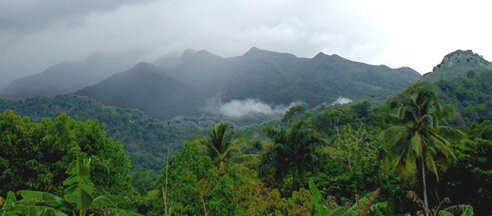 |
|
"According to Legend, the good spirit 'Yuquiyu' reigned on his mighty mountain-top throne, protecting the Taino people."
The Taino people must have made many a spiritual journey to the top of Yuquiyu. It still feels very special at El Yunque, La Roca, Mt. Britton and Los Picachos peaks and an aura of mystery surrounds you in the cloud or dwarf forest!
Here is a link to an interactive little diagram that shows how the clouds and rain are made going up mountains. The winds must rise when they meet the mountains. This rising of the air mass causes the air to cool and release rain on the windward side.
Map of annual rainfall in Puerto Rico.
The intrigue of visiting the El Yunque rain forest is only partly in the observation of the varieties of plants that have managed to grow and adapt to the copious amounts of year round rainfall and winds near the top. The magic of El Yunque is in the pristine beauty, the sounds, the quietness and the serenity.
Los 3 Picachos has a trail to the very top!
This reserve was first set aside by the king of Spain, which then transferred to the federal government in 1898. How did the present lookout towers and trails first become established?
The Civilian Conservation Corps operated in the years between 1933 and 1942. President Franklin D. Roosevelt established the CCC as part of the New Deal Initiative, a program to end the Great Depression. Through this federally funded program, 3,463,766 young men found employment and much needed food, clothing and shelter. Using little else than shovels and axes, the young men of the CCC completed recreation and conservation projects on public lands throughout the United States, Alaska, Hawaii, Puerto Rico and the Virgin Islands. They built roads and towers, developed recreational sites and trails, and engaged in forestry and wildlife improvements. In all of these sites, people today reap the benefits of the work done by the CCC
|
|
|
Post your experience in our blog. EastPR.
|
| |
|
At the very top of the mountain peaks the further increase of both wind and rain creates the dwarf or 'elfin' forest in which few species are able to adapt and cling to the wet soil. Often shrouded in fog, this is a particularly beautiful part of the forest, with its twisted and stunted trunks. Hike the Mt. Britton trail to the tower.
The forest hosts a number of unique plant and animal species such as the endangered Puerto Rican Parrot ( very rarely seen) and the tiny coquis (indigenous tree frogs) that serenade the evening hours.
Coquî tree frogs " Endangered Puerto Rican Parrot
The El Yunque Peak hike and a camping trip.
from the el verde research station web site:
Malaria and yellow fever are absent from Puerto Rico, but dengue fever and schistosomiasis are present in lowland areas. Rabies shot are recommended for those that have to handle mammals.
No dangerous snakes occur in Puerto Rico. The sap of some plants (e.g. Comocladia glabra) can cause a severe reaction similar to poison ivy. Falls from slippery rocks or trees are dangerous and care should be taken in choosing footwear. Bees and wasps are sometimes found in the forest, researchers should bring their own medicines.
The El Yunque National Forest is managed by the US Forest Service who maintain an extensive network of hiking trails. Picnic facilities, paved trails and tour bus parking. The 'El Portal' exhibit hall and lookout towers are on the North side. The South side is the quiet side. You should spend a few nights by the forest to really appreciate the peace and beauty. Rainforest Lodging.
El Yunque is an excellent choice for a rainforest experience. It is a very gentle forest. In fact; there are no poisonous snakes! The need to protect our planets rain forests becomes more apparent as one gains a better understanding through actual experience. . . and the beauty can be overwhelming.
TAKE A PICNIC LUNCH and walk down the steps below the 'Palo Colorado' Ranger Station to the little gazebos below. Two of them are next to a rushing stream.. complete with roof, picnic table, benches and BBQ grill. ( and running water) .
Visit the El Yunque Art Gallery with artist David's' very organic paintings and constructions. Located in Palmer, the little 'town' you drive through just off the highway on your way up to the road #191 that goes up to El Yunque.
A variety of accommodations are available just outside the Park Boundaries. Some next to the rainforest itself and others in the foothills. All have a unique view of the forest and/or the sea. The tranquility experienced during a stay in any one of the small guest houses surrounding the forest refreshes the spirit and will increase your understanding of the rainforest.
Camping is allowed in El Yunque (with a free permit, get it before 3 pm " read camping info.) but it's pretty wet and there are no facilities, no designated camping area. Remember, that the gate closes at 6 pm.
|
| |
Waterfalls and Pools in El Yunque
|
BOOK WITH US NOW ! Reservation Information Enhance your rainforest experience with a naturalist guide and private tour:
John Druitt north side with Island Walkers Private Tours of El Yunque has been a tour guide in Puerto Rico for the last 15 years. His service includes transportation from your hotel or from the bottom of the mountain. Cruise ship passengers, this is the perfect tour operator for you!
Book a snorkeling tour with Elena or just keep reading her website!
Robin Phillips offering hiking tours for more than 15 years. You must provide your own transportation. On the south side only of El Yunque. Robin offers a day long hike to the waterfalls and also will do tours to the Taino Petroglyphs.
Advance Reservations required.
. See below for more El Yunque rainforest VIDEOS
|
|
Visit the El Portal Visitors Center located just below the rainforest.
ENTRANCE FEES TO EL YUNQUE RAINFOREST: There are no entrance fees to visit the forest, you just drive up. If you stop at the El Portal Visitors Center you must pay $3. per person. If you sign up for the Forest Service guided one hour tour you pay a donation of $5. per person ( see below).
EL YUNQUE VISITING HOURS: Visiting hours for the El Yunque rainforest start early and you are not allowed in the forest after 6 pm, unless you have a camping permit. The forest is open 7 days a week.
Forest Tours given by guide/interpreters: You do not need a guide to see the rainforest as the trails are clearly marked.
• US Forest Service Tours of the rainforest 7 days a week , on a first come first served basis. 1 hour tours , they leave on the half hour - 10:30 to 2:30 . Dependent on ranger availability. Tickets are purchased at the Palo Colorado Visitor Center at the heart of the Rec Area. Fee $5 general, $3 seniors & children 12 & under. Walking tours leave Palo Colorado towards the 2 immediate shortest trails. Usually with a group no bigger than 25. Guided tours offer people information for an hour, and then send interested hikers on their way to more challenging trails on their own. For additional information call FOREST SERVICE TELS: 787- 888 -1880. Phone numbers listed as contact for US Forest Service as follows: (787) 888-1810 or (787) 888-1880.
Fax: (787) 888-5685
Web: www.fs.fed.us/r8/el_yunque
• Island Walkers is a Tour company with naturalist guide John Druitt or 'Rubio'. Highly recommended tour operator with lots of experience and knowledge and he can provide transportation as well. If you want to hire a private guide for the ultimate rainforest learning experience. RUBIO TEL. 787-309-6224 or E-mail: < >
|
Why Do Some Rainforest Trees Grow ”Buttress” Roots?
Some of the trees of the El Yunque National Forest’s upper zones have adapted to its unique soil, topography and humid climate conditions by growing “buttress roots,” a type of prop root that grows at the base of the tree trunk, to form a support for the tree. . . article by Alan Mowbray. Read about rainforest soils, climate, topography and the Sierra Palms.
|
|
Hiking is easy on the many cement and dirt trails the US Forest Service maintains. Hike the Mt. Britton trail to the tower
There are often crowds on the north side of the rainforest. The south side ( above the town of Naguabo) is not similarly maintained, yet there are abundant trails and few people. The highest elevation rainforest lodging is located on the south side, in the heart of the forest and the closest beach to the entrance of the North Side is Luquillo Beach and town.
Visit the El Portal Visitors Center located just below the rainforest.
CLICK HERE FOR ELEVATIONS MAP.
Designated Wilderness area and Wild and Scenic Rivers.
Jump into the Rainforest!
Little Coquí frogs sing as the sun goes down.
THE NIGHT SYMPHONY OF THE COQUIS.
|
|
|
Map of the trails to Mt. Britton and the El Yunque peaks above.
|
